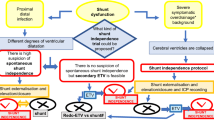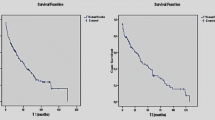Abstract
Purpose
The reported rate is up to 10% of shunt disconnection or fracture, either ventriculoperitoneal or subduroperitoneal. However, not all of shunt discontinuity is associated with shunt malfunction. We analyzed the discontinuity of the shunt system and related factors and tried to present a follow-up policy.
Methods
This is a retrospective study involving 22 patients who presented with shunt disconnection because of malfunction or other reasons between January 2003 and October 2008. To evaluate shunt function, we performed a shuntogram, temporary ligation, or intraoperative exploration.
Results
Nine (40.9%) of 22 patients had nonfunctioning shunts. The shunt system was removed in eight cases, and one patient refused surgical management. Of these 22 patients with disconnected shunts, 17 shunts placed in the occipital area were discontinued. The discontinuations were mostly fractured at neck (52%), not disconnected at connection site.
Conclusion
Shunt disconnection has not been always represented a shunt malfunction. We thought many patients with disconnected shunt may be independent from shunt system, and it can be a good chance for patient to remove the shunt system


Similar content being viewed by others
References
Ahmet Colak ALA, Pollack IF (1997) Follow-up of children with shunted hydrocephalus. Pediatr Neurosurg 27:208–210
Aldrich EF, Harmann P (1990) Disconnection as a cause of ventriculoperitoneal shunt malfunction in multicomponent shunt systems. Pediatr Neurosurg 16:309–311
Drake JM, Kestle JR, Milner R, Cinalli G, Boop F, Piatt J Jr, Haines S, Schiff SJ, Cochrane DD, Steinbok P, MacNeil N (1998) Randomized trial of cerebrospinal fluid shunt valve design in pediatric hydrocephalus. Neurosurgery 43:294–303
Epstein F (1985) How to keep shunts functioning, or “the impossible dream”. Clin Neurosurg 32:608–631
Griebel R, Khan M, Tan L (1985) CSF shunt complications: an analysis of contributory factors. Childs Nerv Syst 1:77–80
BF HJ, Tange M (1987) Danish experience with one-piece shunt. A long term follow-up. Childs Nerv Syst 3:93–96
Howng SL, Lin JN, Sun JM (1985) The complications following ventriculoperitoneal shunt in hydrocephalus patients—clinical analysis. Gaoxiong Yi Xue Ke Xue Za Zhi 1:440–450
Iannelli A, Rea G, Di Rocco C (2005) CSF shunt removal in children with hydrocephalus. Acta Neurochir 147:503–507
Kaiser G (1983) Arrested shunt-independent hydrocephalus. Z Kinderchir 38:73–80
Kang JK, Lee IW (1999) Long-term follow-up of shunting therapy. Childs Nerv Syst 15:711–717
Kast J, Duong D, Nowzari F, Chadduck WM, Schiff SJ (1994) Time-related patterns of ventricular shunt failure. Childs Nerv Syst 10:524–528
Lundar T (1994) Shunt removal or replacement based on intraventricular infusion tests. Childs Nerv Syst 10:337–339
Piatt JH (1996) Hydrocephalus; treatment. McGraw-Hill, New York
Raimondi AJ, Robinson JS, Kuwawura K (1977) Complications of ventriculo-peritoneal shunting and a critical comparison of the three-piece and one-piece systems. Childs Brain 3:321–342
Renier D, Lacombe J, Pierre-Kahn A, Sainte-Rose C, Hirsch JF (1984) Factors causing acute shunt infection. Computer analysis of 1174 operations. J Neurosurg 61:1072–1078
Sainte-Rose C, Piatt JH, Renier D, Pierre-Kahn A, Hirsch JF, Hoffman HJ, Humphreys RP, Hendrick EB (1991) Mechanical complications in shunts. Pediatr Neurosurg 17:2–9
Sekhar LN, Moossy J, Guthkelch AN (1982) Malfunctioning ventriculoperitoneal shunts. Clinical and pathological features. J Neurosurg 56:411–416
Walters BC, Hoffman HJ, Hendrick EB, Humphreys RP (1984) Cerebrospinal fluid shunt infection. Influences on initial management and subsequent outcome. J Neurosurg 60:1014–1021
Acknowledgement
This study was financially supported by the research grant for rising professor, Yonsei University College of Medicine (6-2008-0029).
Author information
Authors and Affiliations
Corresponding author
Rights and permissions
About this article
Cite this article
Lee, YH., Park, E.K., Kim, DS. et al. What should we do with a discontinued shunt?. Childs Nerv Syst 26, 791–796 (2010). https://doi.org/10.1007/s00381-009-1061-x
Received:
Accepted:
Published:
Issue Date:
DOI: https://doi.org/10.1007/s00381-009-1061-x




